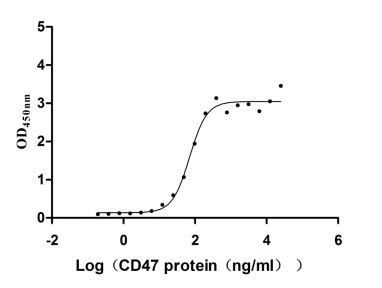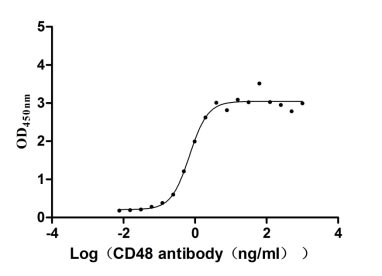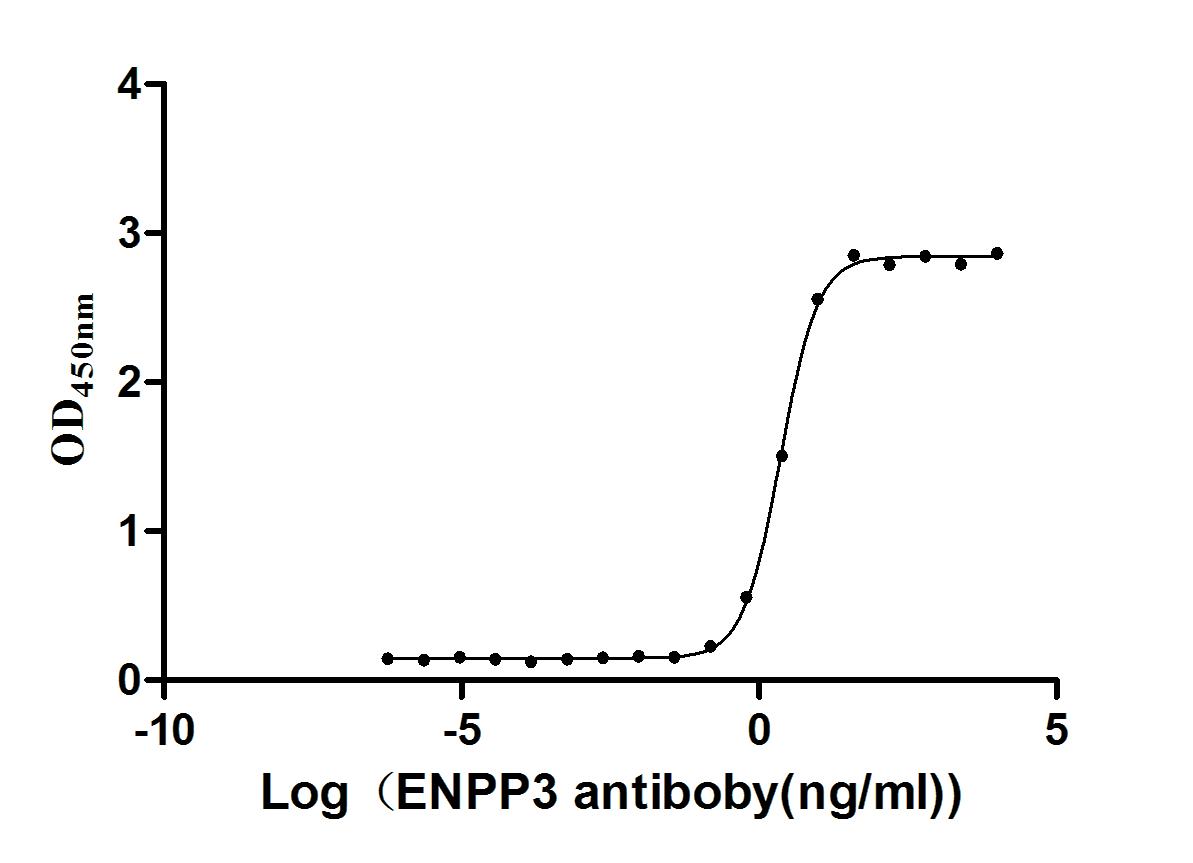Recombinant Mouse Copper transport protein ATOX1 (Atox1)
-
货号:CSB-YP002309MO
-
规格:
-
来源:Yeast
-
其他:
-
货号:CSB-EP002309MO
-
规格:
-
来源:E.coli
-
其他:
-
货号:CSB-EP002309MO-B
-
规格:
-
来源:E.coli
-
共轭:Avi-tag Biotinylated
E. coli biotin ligase (BirA) is highly specific in covalently attaching biotin to the 15 amino acid AviTag peptide. This recombinant protein was biotinylated in vivo by AviTag-BirA technology, which method is BriA catalyzes amide linkage between the biotin and the specific lysine of the AviTag.
-
其他:
-
货号:CSB-BP002309MO
-
规格:
-
来源:Baculovirus
-
其他:
-
货号:CSB-MP002309MO
-
规格:
-
来源:Mammalian cell
-
其他:
产品详情
-
纯度:>85% (SDS-PAGE)
-
基因名:Atox1
-
Uniprot No.:
-
别名:Atox1Copper transport protein ATOX1; Metal transport protein ATX1
-
种属:Mus musculus (Mouse)
-
蛋白长度:Full length protein
-
表达区域:1-68
-
氨基酸序列MPKHEFSVDM TCEGCAEAVS RVLNKLGGVE FNIDLPNKKV CIDSEHSSDT LLATLNKTGK AVSYLGPK
-
蛋白标签:Tag type will be determined during the manufacturing process.
The tag type will be determined during production process. If you have specified tag type, please tell us and we will develop the specified tag preferentially. -
产品提供形式:Lyophilized powder
Note: We will preferentially ship the format that we have in stock, however, if you have any special requirement for the format, please remark your requirement when placing the order, we will prepare according to your demand. -
复溶:We recommend that this vial be briefly centrifuged prior to opening to bring the contents to the bottom. Please reconstitute protein in deionized sterile water to a concentration of 0.1-1.0 mg/mL.We recommend to add 5-50% of glycerol (final concentration) and aliquot for long-term storage at -20℃/-80℃. Our default final concentration of glycerol is 50%. Customers could use it as reference.
-
储存条件:Store at -20°C/-80°C upon receipt, aliquoting is necessary for mutiple use. Avoid repeated freeze-thaw cycles.
-
保质期:The shelf life is related to many factors, storage state, buffer ingredients, storage temperature and the stability of the protein itself.
Generally, the shelf life of liquid form is 6 months at -20°C/-80°C. The shelf life of lyophilized form is 12 months at -20°C/-80°C. -
货期:Delivery time may differ from different purchasing way or location, please kindly consult your local distributors for specific delivery time.Note: All of our proteins are default shipped with normal blue ice packs, if you request to ship with dry ice, please communicate with us in advance and extra fees will be charged.
-
注意事项:Repeated freezing and thawing is not recommended. Store working aliquots at 4°C for up to one week.
-
Datasheet :Please contact us to get it.
靶点详情
-
功能:Binds and deliver cytosolic copper to the copper ATPase proteins. May be important in cellular antioxidant defense.
-
基因功能参考文献:
- ATOX1 appeared ubiquitously expressed throughout the cells until compaction; in subsequent embryo stages, ATOX1 relocalized to cytoplasmic perinuclear domains in the inner cell mass. Silencing of Oct4 did not affect Atox1 expression, but silencing of Atox1 at the 2-cell stage strongly diminished Oct4 expression in 16-cell embryos. PMID: 28711491
- Cu chaperone function of Atox1 mediated through Cu transporter ATP7A is required for VEGF-induced angiogenesis via activation of Cu enzyme lysyl oxidase. PMID: 26437801
- Atox1 is involved in neointimal formation after vascular injury through promoting vascular smooth muscle cell migration and inflammatory cell recruitment in injured vessels PMID: 23349186
- Atox1 functions to prevent Ang II-induced endothelial dysfunction and hypercontraction in resistant vessels, as well as hypertension. PMID: 22753205
- the importance of Atox1, not only as a metallochaperone for delivering Cu to cuproenzymes, but also as a key player in maintaining the proper distribution and organization of Cu at the cellular level PMID: 19865834
- ATOX1 is a cytoplasmic copper chaperone that interacts with the copper-binding domain of the membrane copper transporters ATP7A and ATP7B PMID: 12420134
- Atox1 has a role in establishing the threshold for copper-dependent movement of the copper-transporting ATPases within the secretory compartment PMID: 12538877
- Atox1 functions not only as a copper chaperone for SOD3 but also as a positive regulator for SOD3 transcription and may have an important role in modulating oxidative stress in the cardiovascular system. PMID: 15761197
- Atox1 functions as a novel transcription factor that, when activated by copper, undergoes nuclear translocation, DNA binding, and transactivation, thereby contributing to cell proliferation. PMID: 18245776
- both the copper chaperone and the transcription factor functions are required for the activity of antioxidant enzyme, superoxide dismutase (SOD3) PMID: 18977292
- Atox1 is required for the polyubiquitination of Ctr1 and the Ctr1-mediated uptake of CDDP. PMID: 19124158
- Although Cu concentration in metallothionein (MT)-knockout cells was increased by the knockdown of the copper chaperone, Atox1, the concentrations of 2 other copper metabolizing proteins were paradoxically increased. PMID: 19362104
- Atox1 upregulates prion protein expression. PMID: 19756378
显示更多
收起更多
-
蛋白家族:ATX1 family
-
数据库链接:
KEGG: mmu:11927
STRING: 10090.ENSMUSP00000104485
UniGene: Mm.217759
Most popular with customers
-
Express system: Mammalian cell
Species: Homo sapiens (Human)
-
Recombinant Human CD48 antigen (CD48) (Active)
Express system: Mammalian cell
Species: Homo sapiens (Human)
-
Recombinant Human Nectin-4 (NECTIN4), partial (Active)
Express system: Mammalian cell
Species: Homo sapiens (Human)
-
Recombinant Human C5a anaphylatoxin chemotactic receptor 1 (C5AR1)-VLPs (Active)
Express system: Mammalian cell
Species: Homo sapiens (Human)
-
Express system: Mammalian cell
Species: Homo sapiens (Human)
-
Recombinant Human Claudin-6 (CLDN6)-VLPs, Fluorescent (Active)
Express system: Mammalian cell
Species: Homo sapiens (Human)
-
Recombinant Human C-C chemokine receptor type 8 (CCR8)-VLPs (Active)
Express system: Mammalian cell
Species: Homo sapiens (Human)
-
Recombinant Human CUB domain-containing protein 1 (CDCP1), partial (Active)
Express system: Mammalian cell
Species: Homo sapiens (Human)







f4-AC1.jpg)












